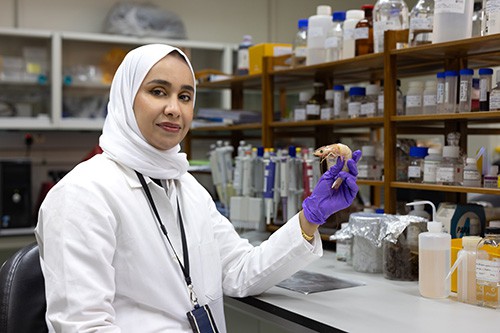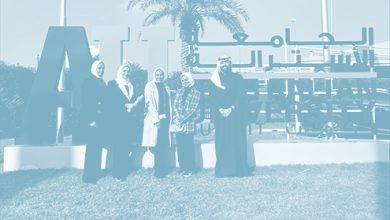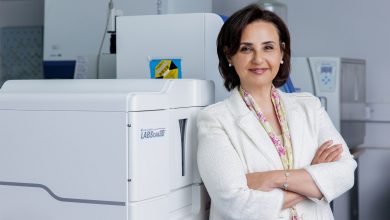The Future of Kuwaiti Aquaculture
Thanks to new research done on a semi-commercial scale, the country is one step closer to establishing an inland shrimp farming industry

With its hot summers and sandy soil, Kuwait is ill-suited to agriculture. However, the nation’s climate is well-suited to certain forms of aquaculture, including shrimp farming. With this in mind, researchers at the Kuwait Institute for Scientific Research (KISR) began studying aquaculture in the 1970s. The institute believes that scaling up shrimp farming in Kuwait could improve the nation’s food security and diversify incomes for local farmers.
Early research on shrimp farming at KISR concerned coastal farms, where shrimp are raised in their natural saltwater habitat. However, Kuwait has limited coastline real estate, and most farmers operate on inland properties, so in 2015, KISR began exploring opportunities for inland shrimp farming. “We wanted to create opportunities for the small- to medium farms located in the inland area,” said Sherain Al-Subiai, an associate research scientist in the mariculture and fisheries department at KISR.
Operating inland shrimp farms presents a host of challenges. The most significant is that groundwater is ill-suited to shrimp farming because it lacks certain elements of seawater that shrimp depend on to survive. This is the issue that Al-Subiai and her colleagues at KISR have been working to overcome through years of research and experimentation. “There are many elements in seawater, which must be looked at one by one,” said Al-Subiai. By adjusting things like magnesium, potassium, and sodium, researchers can make groundwater mimic saltwater and thus create a suitable habitat to foster shrimp far from the coast.
Kuwaiti aquaculture research on a new scale The aquaculture team at KISR had its most significant leap forward in 2019 when the Kuwait Foundation for the Advancement of Sciences (KFAS) gave them a two-year grant to help fund a new research site and conduct experiments on a semi-commercial scale. “Usually, we do our experiments on a small scale at the institute. But I wanted to have data that could be applicable for the commercial sector, and for that, I needed to work at a semi-commercial scale,” said Al-Subiai.
The team established their new research site at Kabd, about 40 kilometers outside Kuwait City and at least 30 kilometers from the nearest coast. It has both outdoor and indoor facilities. The indoor facility hosts a pair of circular tanks where shrimp live during the nursery stage, after they have hatched and before they are large enough to be moved into ponds where they can grow to their full size. There are also three 75-square-meter flow-through systems or raceways located indoors, where shrimp can be cultured at a high density. Outside, there are a pair of earthen ponds, sized 1,500 square meters, also used during the grow-out phase.
Funding from KFAS also allowed researchers to purchase supplies needed to operate the research, including imported shrimp feed, imported shrimp larvae, and various test kits to monitor water quality at the research site and ensure the shrimp were free from diseases. “Without KFAS’ support, this project would not have been possible,” said Al-Subiai.
When the research team began its work, the survival rate of shrimp, meaning how many shrimps stay alive until they’re large enough to be harvested, was less than 20 percent. “Through the project, we increased the survival rate to 72 percent,” she said. “It is a massive increase.” The new survival rate is also much closer to the rate achieved on saltwater farms, which usually measures about 80 percent. Other measurements of success are also on par with what researchers expect on an inland shrimp farm.
The future of inland shrimp farming After two years of KFAS-funded research at Kabd, Al-Subiai is preparing her findings for publication. The results will be published in a major aquaculture journal. For the next stage of their research, Al-Subiai said the team plans to study minor elements, like zinc and copper, which can affect how large the shrimp grow before harvest. The team is also looking for alternatives to replace the expensive salt they add to their water with something less costly and more environmentally friendly.
In the future, this research, Al-Subiai said, could also be applied to farming species of shrimp native to Kuwait. Using native species would decrease the need to import shrimp larvae, making shrimp farming more profitable. The native species are also more popular among local consumers.
A final obstacle to scaling up inland shrimp farming in Kuwait is the lack of know-how among local farmers, but Al-Subiai and her team are addressing this too. With on-site training courses at the Kabd research site, the KISR team prepares farmers to become the first generation of inland shrimp farmers in Kuwait. They offer one training course for beginners and one for those with existing knowledge each year. Course objectives include ensuring farmers understand the infrastructure of an inland shrimp farm, know how to test and adjust water quality, and can diagnose and treat common diseases in shrimp.
With these next steps for the research team and growing interest in training courses each year, the future of shrimp farming in Kuwait is promising. “If you had asked me five years back, I would have said it was impossible to culture shrimp inland,” said Al-Subiai. Today, however, thanks to the determination of the research team at KISR and funding from KFAS, she said, “It is possible, and we can do it in Kuwait.”
By Marianne Dhenin



